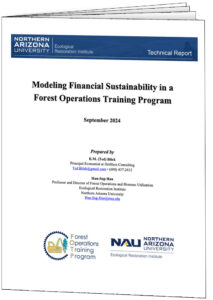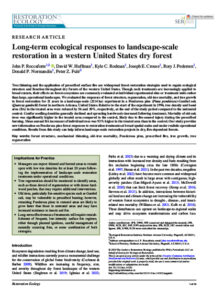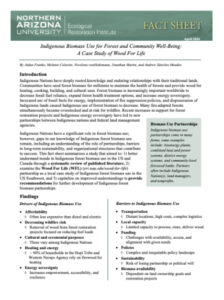Forestry Workforce Training and Development
The ERI is working to provide continuing education for forestry professionals, such as state-of-the-art knowledge on new bioeconomy opportunities and business practices, including forest operations and logistics. The training program would provide much-needed forest operations workforce training, offering forest operations short courses to provide up-to-date information for forest practitioners. In collaboration with major equipment manufacturing companies, a training center would also offer a place to test and demonstrate new mechanized tools as well as implement forest operations and ecological research.
Forest Operations Training Program Development Project
With funding from the U.S. Economic Development Administration, the ERI Forest Operations and Biomass Utilization program has been working to develop a Forest Operations Training Program (FOTP) in northern Arizona to provide career development opportunities that will expand Coconino County’s manufacturing base. To learn more about this project, read the project’s final technical report here.
A spreadsheet-based model called FOTP Analysis was developed to aid in the pre-feasibility and financial feasibility analysis of a forest operations training program (FOTP). This report was developed to aid in the use of the model, and the model is available for free.
Google Sheets FOTP model template
For a guide on how to use the model, please click here.
Modeling Financial Feasibility in a
Forest Operations Training Program
Modeling Financial Feasibility in a
Forest Operations Training Program
Long-term ecological responses to landscape-scale restoration in a western United States dry forest
Tree thinning and prescribed surface fire are common forest restoration strategies in the dry forests of the western United States. These treatments are often assessed at small scales rather than across large areas. This study evaluated forest structure, regeneration, old-tree mortality, and tree growth over 21 years in a large (2114 ha) Ponderosa pine-Gambel oak forest in northern Arizona. By the end of the study, tree density and basal area in the treated area were reduced by 56% and 38%, respectively, compared to the untreated control. Conifer seedling densities generally declined while hardwood sprouting increased post-treatment. Old oak tree mortality was higher in the treated area, likely due to fire injury. The mean annual basal area increment of individual trees was 93% higher in the treated area than in the control. These findings offer valuable insights for large-scale restoration efforts in dry, fire-dependent forests.
Return on investments in restoration and fuel treatments in frequent-fire forests of the American west: A meta-analysis
Arid forests in the American West are overly dense and need fuel reduction and fire regime restoration. Forest restoration efforts, such as thinning and prescribed burning, aim to reduce wildfire risks. Despite their importance, the cost-effectiveness of these programs is not well understood. This study conducted a meta-analysis of 120 observations from 16 studies over the past two decades to evaluate the benefits and costs of forest restoration and fuel treatments. Results showed significant variation in benefits, from enhanced ecosystem services to avoided wildfire costs. In high-value, at-risk watersheds, every dollar invested in restoration yielded up to seven dollars in benefits, achieving a 600% return on investment.




